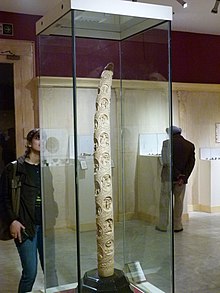Ivory carved tusk depicting Buddha life stories
This tusk, which is nearly five foot long, illustrates forty three events in the life of the Buddha and is thought to have been made by early 20th century craftsmen from the Delhi region.
[2] The use of the complete ivory tusks for carving was popular in 18th and 19th century India, particularly in the Delhi region apart from Burma.
The art of ivory carving in India is very ancient with references found in Kalidasa's Meghadūta.
The earliest ivory carving from the Indian region is comb dating to the 2nd century CE found at Taxila.
Ivory was an object of trade between kingdoms and they found their way into areas where the art of carving had patronage.
